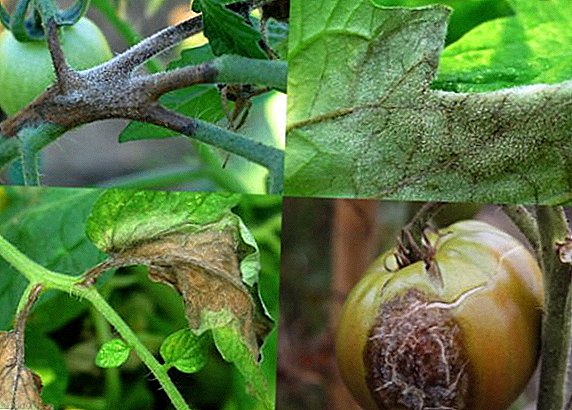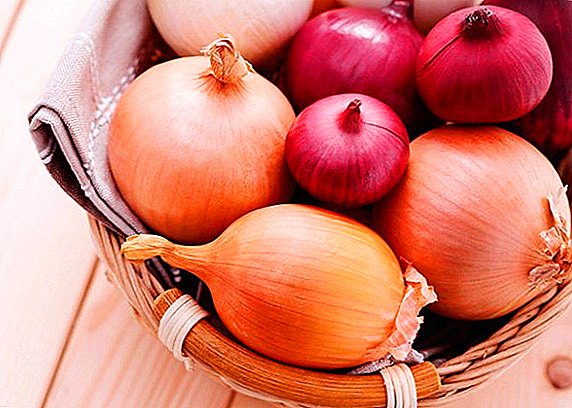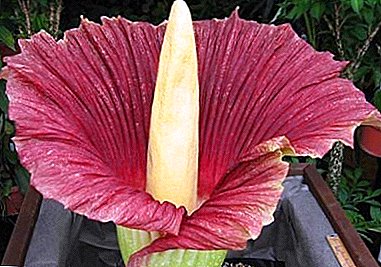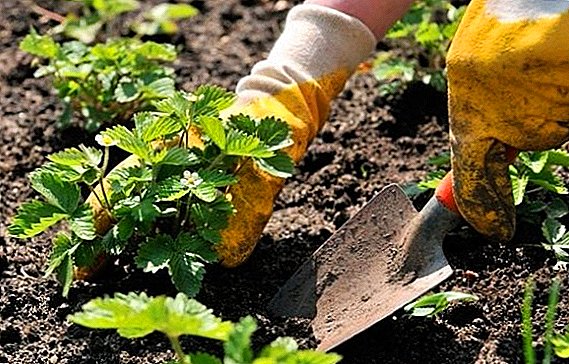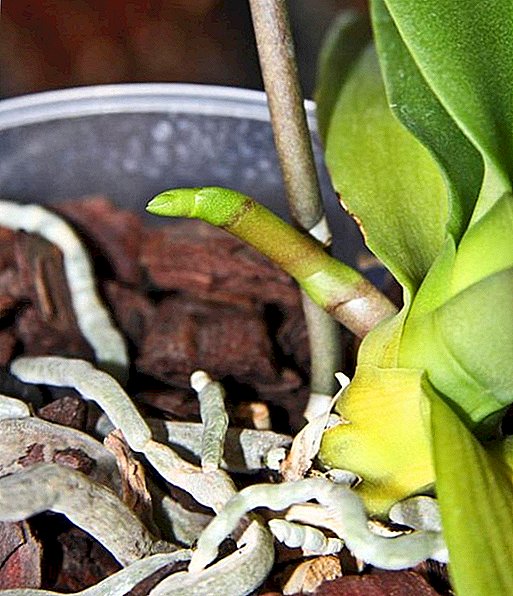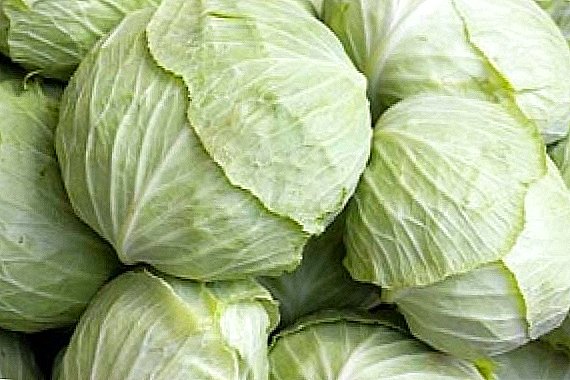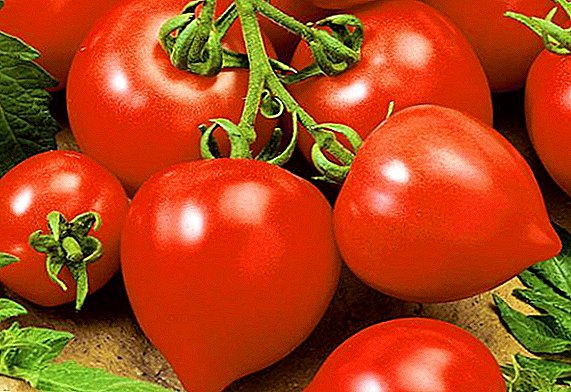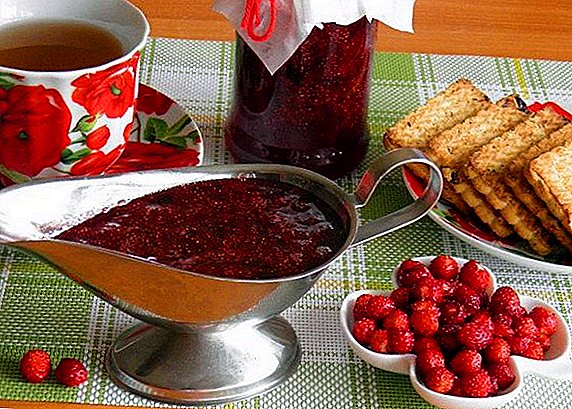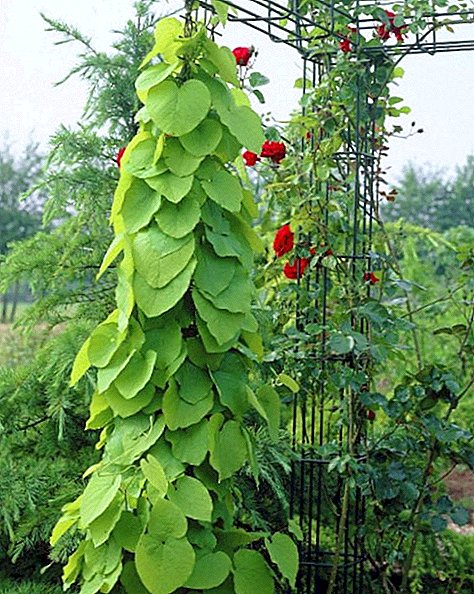 Many owners of household plots are familiar kirkazon, they are happy to plant it in order to decorate the landscape. However, few know that this vine can be used in traditional medicine for the treatment of various diseases. How to grow a plant and treat them - we will consider further.
Many owners of household plots are familiar kirkazon, they are happy to plant it in order to decorate the landscape. However, few know that this vine can be used in traditional medicine for the treatment of various diseases. How to grow a plant and treat them - we will consider further.
Botanical description
Kirkazon or aristolohiya (in Latin - Aristolochia) - is a perennial grass or woody vine (depending on the species). Stems grow straight or curly. The leaves of most representatives resemble the heart, grow alternately one after another, one on the stem.  Flowers have the form of a tubule, opened at the end, around which the petals are located. These plants are bisexual, they have stamens and pistils. Pollinated by insects, attract them with a disgusting smell. In the middle of the tube grow special hairs that do not allow the insect to get inside.
Flowers have the form of a tubule, opened at the end, around which the petals are located. These plants are bisexual, they have stamens and pistils. Pollinated by insects, attract them with a disgusting smell. In the middle of the tube grow special hairs that do not allow the insect to get inside.
In search of a way out, it conducts cross-pollination. When the process is over, the flower immediately fades and the exit is released. Fruits are like cucumbers, balls or pears, dry, consist of walls without flesh inside, in many there are seeds.
Spread
Kirkazon prefers a tropical, sometimes - temperate climate, most often found in Africa, Asia, and America. In Russia, 5 species grow in the Far East, the North Caucasus, in the European part of the country. 
Popular species
Plants of the genus kirkazon unite 485 species, the most popular of which are large-leaf, Manchurian, lomonosovidny and large-flowered.
Important! All types of kirkazona are poisonous, so make sure that children do not poison them in a fit of curiosity.
Large leaf
Large-leaved (pipe) kirkazon is characterized by large leaves in the shape of a heart. The second name of the plant was due to the flowers, which are curved with a check mark, and are shaped like a saxophone. Getting into the middle of this tube, insects can fly out only when they pollinate a flower. Fruits are dry, hollow, have an oblong shape with curved ends, there may be seeds in the middle.  Large-leaved Kirkazon is used to design fences, arbors, tunnels.
Large-leaved Kirkazon is used to design fences, arbors, tunnels.
Manchurian
The leaves of the Manchu kirkazon are similar in shape to the leaves of the previous species, they are about 30 cm in size, they emit camphor smell. By winter, turn yellow and turn brown. The trunk and branches of this creeper form climbing wood. Bright flowers in the shape of a horseshoe-shaped tube with an open “mouth” and petals around it grow from the leaf axils, inside it is beige.
The fruits are similar to cucumbers, they consist of faceted walls and a few seeds inside.  The plant belongs to the endangered and inscribed in the Red Book of Russia.
The plant belongs to the endangered and inscribed in the Red Book of Russia.
Lomonosovidny
The difference between lomonosovogo kirkazona (other names - ordinary, feverish grass, finovnik) is short stature, up to 90 cm. The stem is bare, branches rarely grow. The leaves are round or oval, they smell unpleasantly, the size is about 10 cm. The flowers are tubular, at the ends they widen, taking the shape of the tongue.
Located in the axils of the leaflets in groups. The fruits have the shape of a ball or pear, the walls are thin, there is no pulp, the seeds are cut, up to 10 mm in length.  This vine is a medicinal plant.
This vine is a medicinal plant.
Large-flowered
Large-flowered kirkazon grows in the tropical climate of America and India. His leaves are wide, in the shape of a heart. The flowers are large, in the form of a funnel, they smell like rotten meat to seduce the flies and wasps.
Did you know? It turns out that the well-known vanilla is the fruit of the vines of the orchid family.
In folk medicine, Colombia, the plant is used to treat snake bites, against microbes, to improve the tone of the uterus, against cancer (causes changes in the cells). He is eagerly eaten by butterflies-gentlemen. 
Medicinal properties
Aristolokhin is present in the chemical composition of a Kirkazon, this substance has such useful properties:
- bactericidal action;
- diaphoretic action;
- diuretic action;
- analgesic effect;
- lowers the temperature;
- soothes inflammatory processes;

Also, inflammatory processes can help relieve: birch, black poplar, monard, prince, kalgan root, aspen and kalanchoe.
- helps to reduce uterus;
- dilates blood vessels;
- accelerates heartbeat;
- activates the central nervous system;
- promotes rhythmic breathing.
Thanks to these properties of the plant, traditional medicine has found its effectiveness in such health problems:
- skin inflammation;
- gastrointestinal problems;
- urinary tract infection;
- diseases of the respiratory system;
- gynecological problems;
- bile stasis;
- colds;
- joint diseases;
- accumulation of fluid in the tissues;
- high blood pressure.

Important! It is necessary to use medications on the basis of kirkazon inside strictly according to the recommendation of the doctor and only under his supervision.
Use in traditional medicine
In folk medicine on the basis of Kirkazon make decoctions for lotions and baths, tinctures, ointments. Apply mainly externally, since the internal use is limited to the poisonous properties of the plant.
For cooking decoction of the stems Aristolochia 2 tablespoons of dry raw material is poured with a glass of water, allowed to boil and cook for 15 minutes. Then it is kept at room temperature for cooling and filtered.  This decoction is used to treat eczema, neurodermatitis, boils, carbuncles, fungus, psoriasis, and other skin inflammations. For treatment, the affected area is washed with broth, make a compress or lotion.
This decoction is used to treat eczema, neurodermatitis, boils, carbuncles, fungus, psoriasis, and other skin inflammations. For treatment, the affected area is washed with broth, make a compress or lotion.
For the treatment of various skin diseases and eczema use: cornflower, celandine, dodder, lovage, yucca, echinacea, fir, wild rosemary, marsh, savory, succession, elecampane and enoteru.
Decoction of the root of aristolohii cooked in the same way, but instead of the stems, use 1 tablespoon of dried and chopped root, which is poured with a glass of water, allowed to boil and cook for 15 minutes. After cooling, the broth is added to warm water.
Baths with him take up to 20 minutes, not longer. This method is used in the treatment of gout, salt deposits, arthritis, arthrosis and other problems with the joints, as well as melanoma.
To prepare spirit tincture kirkazona, you need 1 tablespoon of crushed dry stalks of the plant, pour 3 tablespoons of alcohol with a strength of at least 70% and put in a dark place for 3 weeks. Apply it to disinfect wounds, treatment of boils, felon, mastitis, other inflammatory processes.  Kirkasonovy ointment made on the basis of stalks and domestic pig fat. The fat is melted in a water bath and poured into another bowl. 0.5 l of melted lard is mixed with 100 g of dried and shredded stems of kirkazon and kept in a water bath for 2 hours.
Kirkasonovy ointment made on the basis of stalks and domestic pig fat. The fat is melted in a water bath and poured into another bowl. 0.5 l of melted lard is mixed with 100 g of dried and shredded stems of kirkazon and kept in a water bath for 2 hours.
Make sure that the water does not boil over. Then the ointment is cooled and stored in the refrigerator. Before use, the required amount of ointment is maintained at room temperature until softened. Apply with diseases of the joints, rubbing into the sore spots in the morning and evening.
Harm and side effects
As part of the Kirkazon is aristolokhichesky acid, which is capable of causing a malignant tumor, and its action may occur even after 10 years. If you use drugs on the basis of aristolochia inside without medical supervision, you run the risk of developing liver or kidney cancer and other serious kidney diseases.
An overdose of Kirkazon tincture may cause paralysis of the respiratory tract. External use of drugs can cause allergic reactions, burns, pain. Means based on kirkazona can be absorbed inside through the skin and mucous membranes, having a toxic effect on the central nervous system.
Contraindications
Treatment with drugs based on aristolochia is contraindicated:
- pregnant women (may cause termination of pregnancy);
- nursing mothers;
- children;
- with gastritis;
- in diseases of the kidneys and liver.

Care and cultivation of seedlings at home
Kirkazon adapts very well, so it is suitable for cultivation in our latitudes, but still it is worth getting acquainted with some peculiarities of cultivation and care for it.
Choice of location and lighting
The best place for growing aristolochia is sunny, however, a little shaded will do, and large leaves can survive in the shade.
Kirkazon is not afraid of noise, dust, polluted atmosphere, but there is one caveat - the landing site should not be on the leeward side. Firstly, it will grow badly, and secondly, inflating the foliage, the wind will not let you admire the beauty of the vines. Since the plant loves moisture, it is best to choose a place for it near the reservoir.
Substrate and fertilizer preparation
For normal growth, aristolochia requires fertile, moist and loose soil rich in organic compounds.  It is necessary to prepare the soil for planting in advance - dig holes, collect and enrich the ground. Sand, humus in the ratio of 1 to 1, turf, peat, compost, clay, and mineral fertilizers are added to the ground.
It is necessary to prepare the soil for planting in advance - dig holes, collect and enrich the ground. Sand, humus in the ratio of 1 to 1, turf, peat, compost, clay, and mineral fertilizers are added to the ground.
Important! Make sure that the turf and compost do not contain elements of coniferous trees - the kirkazon does not like this.
Planting and breeding
At the bottom of the hole with a depth and width of 50 cm, pour a layer of expanded clay and sprinkle it with sand. The holes are dug in such a way that each plant is at least 80 cm away from the others, otherwise the roots will have nowhere to grow. Near the hole they instill a strong support that can withstand the weight of the vine, and correspond to its height.
Before planting, the roots are cut from saplings: a fifth of the strong roots and a third of the weak. Deepen the seedling in the hole so that the top of the root is at the same height with the ground. Now you can fall asleep prepared substrate.
Kirkazon multiplies seeds, shoots, cuttings, cut off the roots, and also gives new shoots from the roots.  Propagation of aristolochia by seeds is problematic because of the rapid loss of their germination and poor maturation (as in the elegant Kirkazon).
Propagation of aristolochia by seeds is problematic because of the rapid loss of their germination and poor maturation (as in the elegant Kirkazon).
The seeds collected in autumn should be sown in the prepared soil for 2-3 months. When sprouts appear, the plants are planted in separate containers (if grown in 1 container, then keep at least 20 cm distance) and grown in this way for 2-3 years, then planted in open ground. Be prepared for the growth to be very slow.
Did you know? Black, white, green and pink pepper is the same fruit, only processed differently, and it grows on a vine called black pepper.
In the spring, you can lay in the ground processes of vines, until the fall, they will take root and become a separate plant.
Propagation by cuttings is a laborious process; it is used mainly for graceful aristolochia only. To do this, cutting branches in spring, you need to make cuttings of about 30 cm in length, plant them in a pot with a prepared substrate, pour and cover with a cap. After 2-3 months, the vine can be transplanted into open ground.
Kirkazon cuttings can be prepared in the fall, but then it should be planted in open ground in spring.
Through the root system only lomonosovy kirkazon breeds. To do this, in spring a piece of a root about 10 cm long of average thickness is cut off and buried in the prepared soil to a depth of about 5 cm, then watered. Liana begins to grow after a few weeks.
Watering, humidity, care
The land around the Kirkazon should be regularly loosened, trying not to damage the roots. To make the weeds grow worse, and the plant is enriched with nutrients, the soil around it must be covered with leaves or other objects of organic origin.  Kirkazon loves moisture, it must often be watered and sprayed, especially in summer in the heat: at least 2 times a week for 10 l per vine. In the summer, organic fertilizers are also applied once a month - 5 liters of a weak solution per liana.
Kirkazon loves moisture, it must often be watered and sprayed, especially in summer in the heat: at least 2 times a week for 10 l per vine. In the summer, organic fertilizers are also applied once a month - 5 liters of a weak solution per liana.
It will be useful for you to read about how to make drip irrigation from improvised means or plastic bottles with your own hands, and also learn about the advantages of automatic watering.
Aristolochia is growing rapidly, so overgrown or weak branches should be cut off.
Wintering
At home, kirkazon grows in a warm climate, but adult plants tolerate winter well, and therefore do not need protection. It may happen that in severe frosts some branches may suffer, but in spring they will come alive again.
However, before reaching the age of three, the vines need protection: they are removed from the support, sprinkled with an 8 cm layer of dry leaves. You can use covering materials, as well as additionally sprinkle with snow.
In this case, the aristolochia graceful requires special care, it should be transferred to the shelter for the winter, therefore, it is recommended to plant the plant not in open ground, but in large pots. 
Diseases and pests
Kirkazon is rarely exposed to pests, but the spider mite and aphid are its enemies. In order to prevent the emergence of parasites, the plants must be sprayed, and during infection, they must be treated with chemicals intended to destroy them (Aktellik, Fitoverm). Among traditional methods, a decoction based on creeping bitter is known: bring 120 g of leaves to 1 liter of water to a boil, insist for 24 hours.
Read more about how to deal with spider mites.
Diseases characteristic of lianas are powdery mildew and rot, they appear when the distance between plants is not maintained, or overdone with watering. In these cases, infected plants are cut and sprayed with special preparations ("Fundazol", "Topaz") or folk remedies (solution of potassium permanganate, infusion of garlic).
Harvesting and storage of raw materials
For treatment, use the upper part of the stem and root of kirkazona. The first one is harvested in spring when the vine blooms and the roots in the fall.  Raw materials are carefully cut, washed, dried, spread in 1 layer in a room with good access to air or use electric drying.
Raw materials are carefully cut, washed, dried, spread in 1 layer in a room with good access to air or use electric drying.
Important! While working with raw materials, you should wear thick rubber gloves on your hands, as there is a danger of poisoning.
Suitability to use of raw materials keeps within 2 years if to store it packed up in a paper container in the dry dark room.
Use in landscape design
Kirkazon is simply indispensable if you need to hide a barn or other economic structure, protect the house from street dust, decorate a gazebo, a tree, make a corridor in front of the house or an elegant arch.  From the foregoing, it follows that kirkazon can decorate any area without requiring particularly difficult growing conditions.
From the foregoing, it follows that kirkazon can decorate any area without requiring particularly difficult growing conditions.
We recommend to read how other types of lianas are used in landscape design: terry calysetia, prince, wood-pliers, tunbergia and amber amber dichondra.
In addition, from the stems and roots of the plant, you can prepare a number of funds for the treatment of traditional methods. However, caution should be exercised, especially if you decide on an internal medication.


